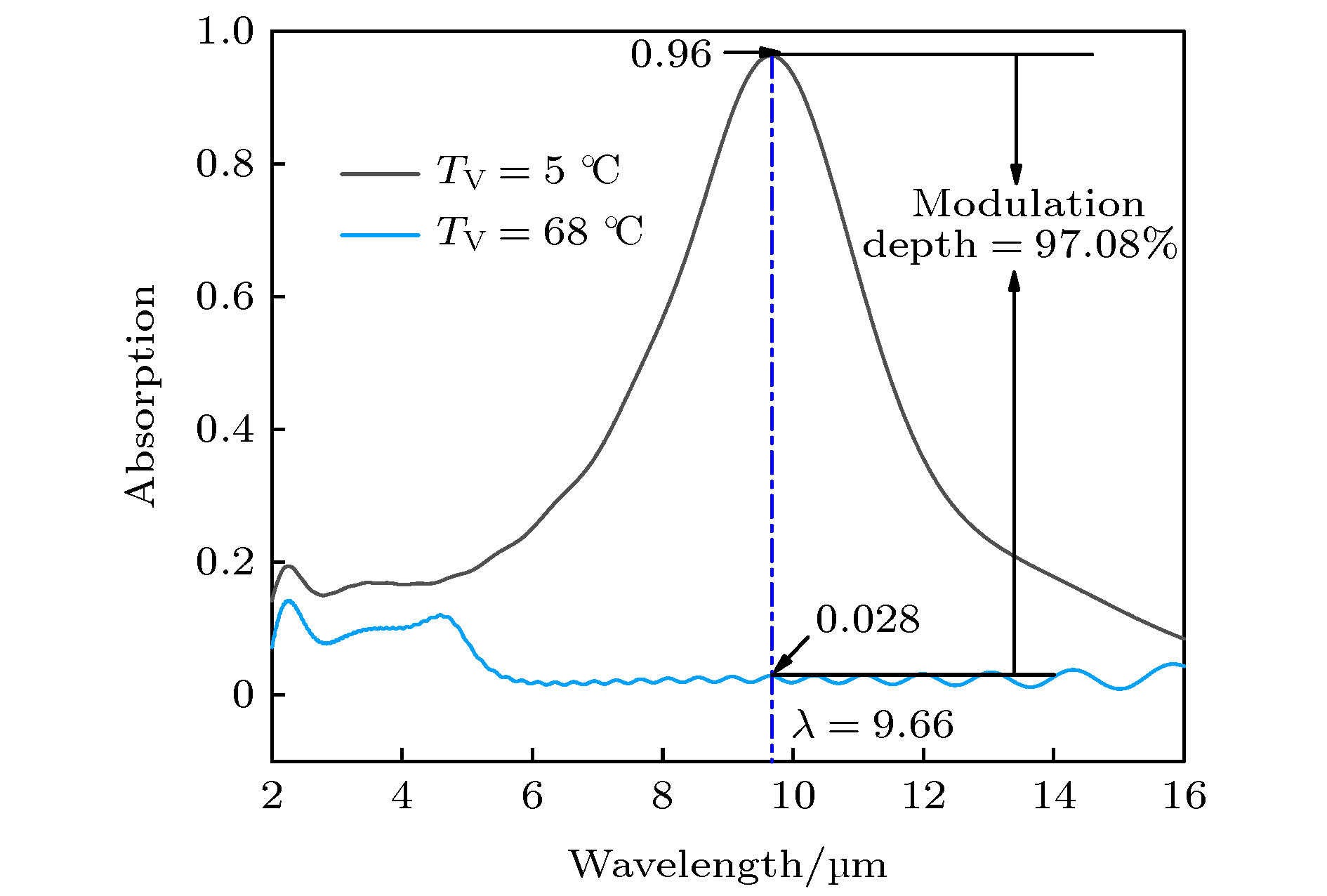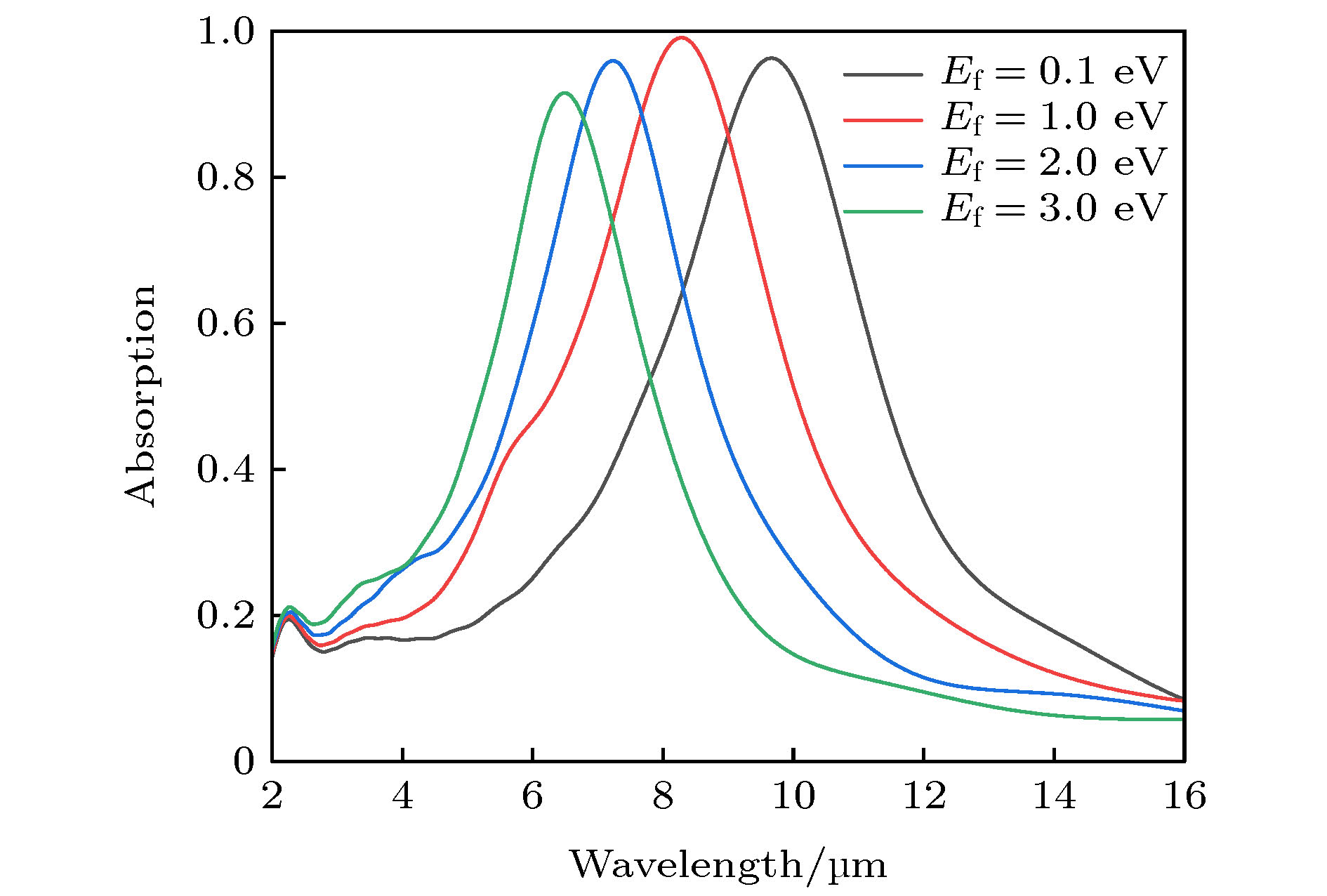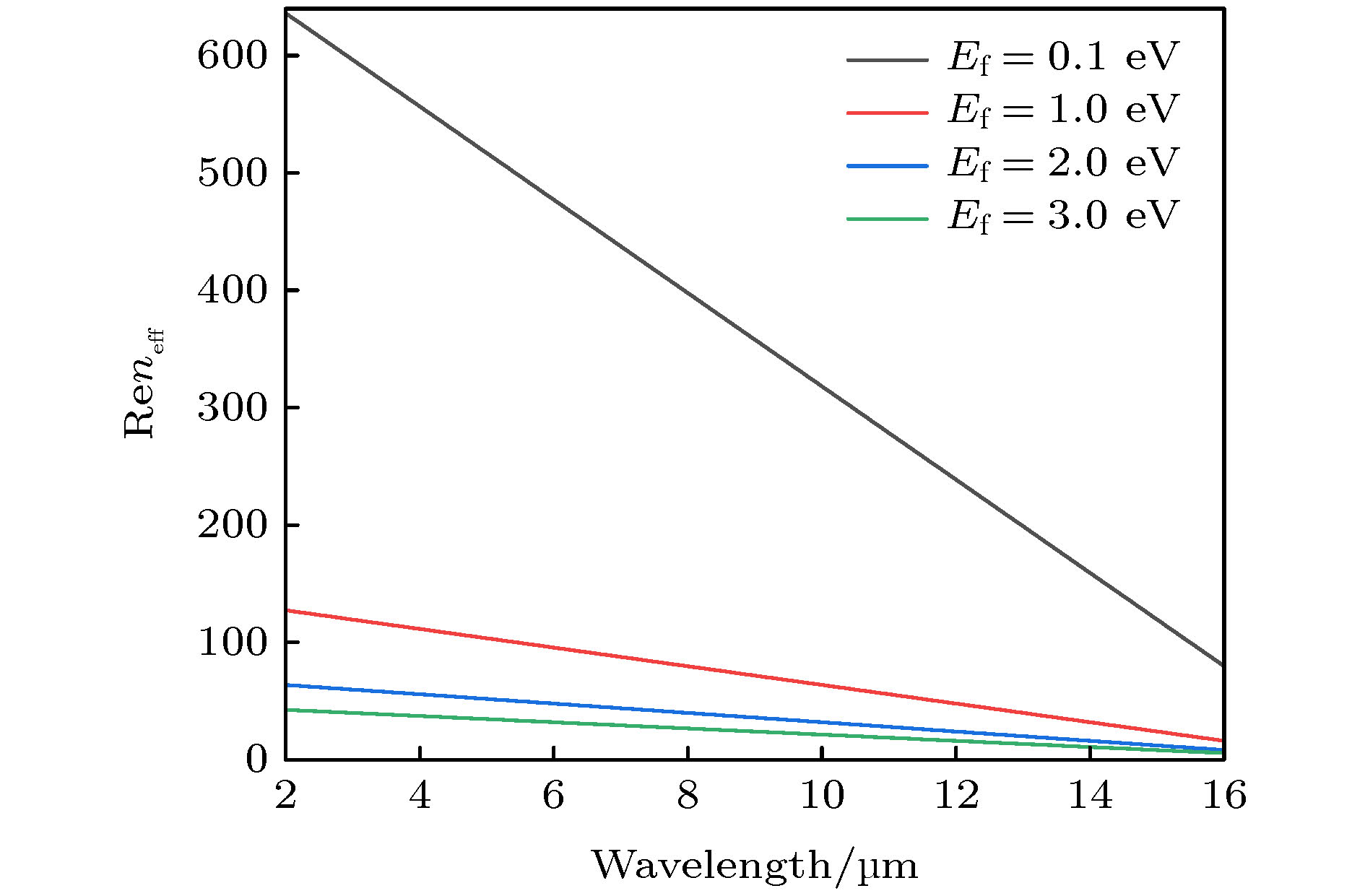-
为了使超材料完美吸收器(metamaterial perfect absorber, MPA)能够同时实现吸收效率和吸收波长的控制, 本文提出利用二氧化钒(VO2)和石墨烯作为MPA的材料, 通过对MPA的结构设计, 在红外波段实现了高吸收, 吸收效率最高可达99%. 研究发现通过改变VO2的温度和石墨烯的化学势, 可同时实现MPA吸收效率和吸收波长的控制, 吸收效率调制深度和吸收波长调谐范围分别可达97.08%和3.2 μm. 通过对MPA在吸收波长处的磁场分布分析可以得出, MPA能够产生高吸收是由于其形成了法布里-帕罗(Fabry-Pérot, FP) 干涉腔共振, 研究发现MPA的结构参数对FP腔的共振波长具有显著的影响.The metamaterial perfect absorber (MPA) is a new type of electromagnetic wave absorber first proposed by Landy. Compared with the traditional electromagnetic wave absorber, MPA has many advantages, including ultra-high absorption efficiency, ultra-thin, compact structure, easily tunable resonances, etc. so it is gradually applied to ultra-sensitive sensing, imaging, detection and other fields. Nowadays, the MPA research focuses on two areas. One area focuses on the absorption efficiency modulation and absorption wavelength tuning, and the other area is to broaden the absorption bandwidth and achieve high absorptions at different optical frequencies. Previously, the MPA absorption efficiency modulation or absorption wavelength tuning was realized by changing the device structure or the surrounding medium material. But these methods can increase the difficulty in processing and increase the device volume. In order to achieve the control of absorption wavelength and absorption efficiency without increasing the difficulty in processing or the device volume. We propose to use vanadium dioxide and graphene as the materials of MPA, which has high absorption efficiency in the infrared band. It is found that the absorption efficiency of MPA at 9.66 μm wavelength can reach 96% when the temperature of vanadium dioxide is 5 ℃ by using finite difference time domain (FDTD) method. However, when the vanadium dioxide temperature rises to 68 ℃, the absorption efficiency of MPA suddenly drops to 2.8%. The modulation depth of absorption efficiency can reach 97.08%. We propose that the MPA be able to control not only the absorption efficiency, but also the absorption wavelength. By changing the voltage of graphene, the chemical potential Ef of graphene can be controlled and the absorption wavelength of MPA can be tuned. When Ef increases from 0.1 eV to 3 eV, the absorption wavelength of MPA will be blue-shifted from 9.66 μm to 6.46 μm. The magnetic field distribution of MPA at the absorption wavelength shows that the MPA has a high absorption efficiency because of the Fabry-Pérot (FP) cavity resonance is formed in MPA. Therefore, the change of structure parameters of MPA will affect its absorption characteristics. It is found by the FDTD method that the absorption wavelength of MPA will be redshifted, when the radius, thickness, period and thickness of the nanocolumn array increase. This study can provide theoretical guidance for designing and preparing the controllable MPA, which has compact structure and low process difficulty merits.
-
Keywords:
- metamaterial /
- absorber /
- vanadium dioxide /
- graphene
[1] Landy N I, Sajuyigbe S, Mock J J, Smith D R, Padilla W J 2008 Phys. Rev. Lett. 100 207402
 Google Scholar
Google Scholar
[2] Liu X L, Starr T, Starr A F, Padilla W J 2010 Phys. Rev. Lett. 104 207403
 Google Scholar
Google Scholar
[3] Lei L, Li S, Hang H X, Tao K Y, Xu P 2018 Opt. Express 8 1031
 Google Scholar
Google Scholar
[4] Wen D, Yue F, Li G, Zheng G, Chan K, Chen S, Chen M, Li K F 2015 Nat. Commun. 6 8241
 Google Scholar
Google Scholar
[5] Chen L, Liao D G, Guo X G 2019 Front. Inform. Technol. Electron. Eng. 20 591
 Google Scholar
Google Scholar
[6] Bian B, Liu S, Wang S 2013 J. Appl. Phys. 114 194511
 Google Scholar
Google Scholar
[7] Yin S, Zhu J F, Xu W D, Jiang W, Yuan J, Yin G 2015 Appl. Phys. Lett. 107 073903
 Google Scholar
Google Scholar
[8] Xiao Z, Tang J 2017 Mater. Lett. 192 21
 Google Scholar
Google Scholar
[9] Shrekenhamer D, Chen W C, Padilla W J 2013 Phys. Rev. Lett. 110 177403
 Google Scholar
Google Scholar
[10] Ling K, Kim H K, Yoo M, Lim S 2015 Sensors (Basel) 15 28154
 Google Scholar
Google Scholar
[11] Liu M K, Susli M, Silva D, Putrino G, Kala H, Fan S T, Cole M 2017 Microsyst. Nanoeng. 3 17033
 Google Scholar
Google Scholar
[12] Hashemi M R M, Yang S H, Wang T 2016 Sci. Rep. 6 35439
 Google Scholar
Google Scholar
[13] Pradhan J K, Ramakrishna S A, Rajeswaran B 2017 Opt. Express 25 9116
 Google Scholar
Google Scholar
[14] Naorem R, Dayal G, Anantha Ramakrishna S 2015 Opt. Commun. 346 154
 Google Scholar
Google Scholar
[15] Liu Z M, Li Y 2017 J. Phys. D Appl. Phys. 50 38
[16] 陈浩, 张晓霞, 王鸿, 姬月华 2018 67 118101
 Google Scholar
Google Scholar
Chen H, Zhang X X, Wang H, Ji Y H 2018 Acta Phys. Sin. 67 118101
 Google Scholar
Google Scholar
[17] 李小兵, 陆卫兵, 刘震国, 陈昊 2018 67 184101
 Google Scholar
Google Scholar
Li X B, Lu W B, Liu Z G, Chen H 2018 Acta Phys. Sin. 67 184101
 Google Scholar
Google Scholar
[18] Yao G, Ling F, Yue J 2016 Opt. Express 24 1518
 Google Scholar
Google Scholar
[19] Fan C Z, Tian Y C, Ren P W 2019 Chin. Phys. B 28 076105
 Google Scholar
Google Scholar
[20] Ding C F, Jiang L K, Wu L, Gao R M 2015 Opt. Commun. 350 103
 Google Scholar
Google Scholar
[21] Lee K, Choi H J, Son J 2015 Sci. Rep. 5 14403
 Google Scholar
Google Scholar
[22] 杨海波, 胡明, 梁继然 2008 物理化学学报 6 101
Yang L B, Hu M, Liang J R 2008 Acta Phys.-Chim. Sin. 6 101
[23] Kischkat J, Peters S, Gruska B 2012 Appl. Optics 51 6789
 Google Scholar
Google Scholar
[24] Su Z, Yin J, Zhao X 2015 Opt. Express 23 1679
 Google Scholar
Google Scholar
[25] 江孝伟, 武华, 袁寿财 2019 68 138101
 Google Scholar
Google Scholar
Jiang X W, Wu H, Yuan S C 2019 Acta Phys. Sin. 68 138101
 Google Scholar
Google Scholar
[26] 张会云, 黄晓燕, 陈琦 2016 65 18101
 Google Scholar
Google Scholar
Zhang H Y, Huang X Y, Chen Q 2016 Acta Phys. Sin. 65 18101
 Google Scholar
Google Scholar
[27] Lu H, Cumming B P, Gu M 2015 Opt. Lett. 40 3647
 Google Scholar
Google Scholar
[28] 乔文涛, 龚健, 张利伟 2015 64 237301
 Google Scholar
Google Scholar
Qiao W T, Gong J, Zhang L W 2015 Acta Phys. Sin. 64 237301
 Google Scholar
Google Scholar
[29] Vasko F T, Ryzhii V 2007 Phys. Rev. B 76 233404
 Google Scholar
Google Scholar
[30] Mun B S, Yoon J, Mo S K 2013 Appl. Phys. Lett. 103 1039
 Google Scholar
Google Scholar
[31] Currie M, Mastro M A, Wheeler V D 2017 Opt. Mater. Express 7 1697
 Google Scholar
Google Scholar
[32] Yao Y, Kats M A, Genevet P, Yu N, Song Y 2013 Nano Lett. 13 1257
 Google Scholar
Google Scholar
[33] Vakil A, Engheta N 2011 Science 332 1291
 Google Scholar
Google Scholar
-
-
[1] Landy N I, Sajuyigbe S, Mock J J, Smith D R, Padilla W J 2008 Phys. Rev. Lett. 100 207402
 Google Scholar
Google Scholar
[2] Liu X L, Starr T, Starr A F, Padilla W J 2010 Phys. Rev. Lett. 104 207403
 Google Scholar
Google Scholar
[3] Lei L, Li S, Hang H X, Tao K Y, Xu P 2018 Opt. Express 8 1031
 Google Scholar
Google Scholar
[4] Wen D, Yue F, Li G, Zheng G, Chan K, Chen S, Chen M, Li K F 2015 Nat. Commun. 6 8241
 Google Scholar
Google Scholar
[5] Chen L, Liao D G, Guo X G 2019 Front. Inform. Technol. Electron. Eng. 20 591
 Google Scholar
Google Scholar
[6] Bian B, Liu S, Wang S 2013 J. Appl. Phys. 114 194511
 Google Scholar
Google Scholar
[7] Yin S, Zhu J F, Xu W D, Jiang W, Yuan J, Yin G 2015 Appl. Phys. Lett. 107 073903
 Google Scholar
Google Scholar
[8] Xiao Z, Tang J 2017 Mater. Lett. 192 21
 Google Scholar
Google Scholar
[9] Shrekenhamer D, Chen W C, Padilla W J 2013 Phys. Rev. Lett. 110 177403
 Google Scholar
Google Scholar
[10] Ling K, Kim H K, Yoo M, Lim S 2015 Sensors (Basel) 15 28154
 Google Scholar
Google Scholar
[11] Liu M K, Susli M, Silva D, Putrino G, Kala H, Fan S T, Cole M 2017 Microsyst. Nanoeng. 3 17033
 Google Scholar
Google Scholar
[12] Hashemi M R M, Yang S H, Wang T 2016 Sci. Rep. 6 35439
 Google Scholar
Google Scholar
[13] Pradhan J K, Ramakrishna S A, Rajeswaran B 2017 Opt. Express 25 9116
 Google Scholar
Google Scholar
[14] Naorem R, Dayal G, Anantha Ramakrishna S 2015 Opt. Commun. 346 154
 Google Scholar
Google Scholar
[15] Liu Z M, Li Y 2017 J. Phys. D Appl. Phys. 50 38
[16] 陈浩, 张晓霞, 王鸿, 姬月华 2018 67 118101
 Google Scholar
Google Scholar
Chen H, Zhang X X, Wang H, Ji Y H 2018 Acta Phys. Sin. 67 118101
 Google Scholar
Google Scholar
[17] 李小兵, 陆卫兵, 刘震国, 陈昊 2018 67 184101
 Google Scholar
Google Scholar
Li X B, Lu W B, Liu Z G, Chen H 2018 Acta Phys. Sin. 67 184101
 Google Scholar
Google Scholar
[18] Yao G, Ling F, Yue J 2016 Opt. Express 24 1518
 Google Scholar
Google Scholar
[19] Fan C Z, Tian Y C, Ren P W 2019 Chin. Phys. B 28 076105
 Google Scholar
Google Scholar
[20] Ding C F, Jiang L K, Wu L, Gao R M 2015 Opt. Commun. 350 103
 Google Scholar
Google Scholar
[21] Lee K, Choi H J, Son J 2015 Sci. Rep. 5 14403
 Google Scholar
Google Scholar
[22] 杨海波, 胡明, 梁继然 2008 物理化学学报 6 101
Yang L B, Hu M, Liang J R 2008 Acta Phys.-Chim. Sin. 6 101
[23] Kischkat J, Peters S, Gruska B 2012 Appl. Optics 51 6789
 Google Scholar
Google Scholar
[24] Su Z, Yin J, Zhao X 2015 Opt. Express 23 1679
 Google Scholar
Google Scholar
[25] 江孝伟, 武华, 袁寿财 2019 68 138101
 Google Scholar
Google Scholar
Jiang X W, Wu H, Yuan S C 2019 Acta Phys. Sin. 68 138101
 Google Scholar
Google Scholar
[26] 张会云, 黄晓燕, 陈琦 2016 65 18101
 Google Scholar
Google Scholar
Zhang H Y, Huang X Y, Chen Q 2016 Acta Phys. Sin. 65 18101
 Google Scholar
Google Scholar
[27] Lu H, Cumming B P, Gu M 2015 Opt. Lett. 40 3647
 Google Scholar
Google Scholar
[28] 乔文涛, 龚健, 张利伟 2015 64 237301
 Google Scholar
Google Scholar
Qiao W T, Gong J, Zhang L W 2015 Acta Phys. Sin. 64 237301
 Google Scholar
Google Scholar
[29] Vasko F T, Ryzhii V 2007 Phys. Rev. B 76 233404
 Google Scholar
Google Scholar
[30] Mun B S, Yoon J, Mo S K 2013 Appl. Phys. Lett. 103 1039
 Google Scholar
Google Scholar
[31] Currie M, Mastro M A, Wheeler V D 2017 Opt. Mater. Express 7 1697
 Google Scholar
Google Scholar
[32] Yao Y, Kats M A, Genevet P, Yu N, Song Y 2013 Nano Lett. 13 1257
 Google Scholar
Google Scholar
[33] Vakil A, Engheta N 2011 Science 332 1291
 Google Scholar
Google Scholar
计量
- 文章访问数: 11597
- PDF下载量: 303
- 被引次数: 0














 下载:
下载:









